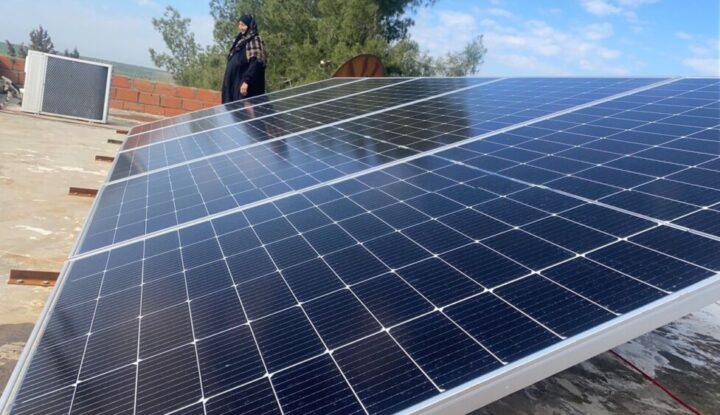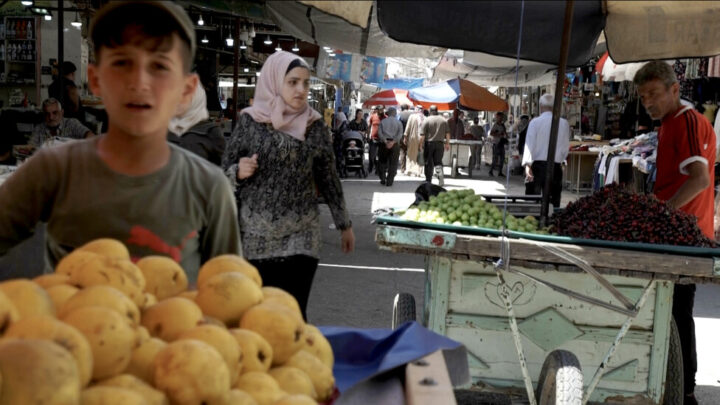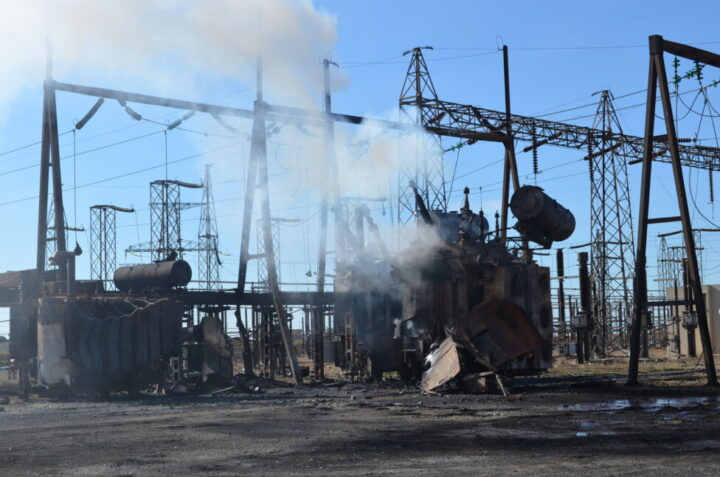ARTICLE AD
 An oil production field near Rumilan, in Syria´s northeast, shortly after being hit by Turkish drones. Oil is one of the main sources of income for the entire Kurdish region. Credit: Jewan Abdi/IPSby Jewan Abdi, Arkan Sloo (qamishli, syria)Thursday, February 29, 2024Inter Press Service
An oil production field near Rumilan, in Syria´s northeast, shortly after being hit by Turkish drones. Oil is one of the main sources of income for the entire Kurdish region. Credit: Jewan Abdi/IPSby Jewan Abdi, Arkan Sloo (qamishli, syria)Thursday, February 29, 2024Inter Press ServiceQAMISHLI, Syria, Feb 29 (IPS) - The Ramsys, a farming couple from northeast Syria, never thought they'd spend almost all their savings on solar panels. “We’ve paid 1,700 USD. We simply couldn't cope with darkness and being disconnected from the outside world,” Najma Ramsy tells IPS from her residence in Keshka, a small Kurdish village 70 km east of Qamishli.
Ramsy admits she still needs to familiarise herself with the new device, mirroring the sky from the house roof. It's also a reminder of an ongoing threat.
“It's devastating. The Turks are shelling us almost daily. I will never forget how our house trembled when the oil pump station nearby was hit,” she recalls.
Although under-reported in the international media, bombing raids have been common currency in this region over the last few years.
A report released last January by the Rojava Information Centre —an independent and volunteer-staffed organisation— points to a “periodic airstrikes campaign” conducted by Turkey against civilian infrastructures in Syria's northeast. Moreover, hundreds of civilians have been killed.
The RIC says the bombing campaign started when Ankara launched a cross-border attack against the Syrian Kurdish region of Serekaniye in 2019, giving air support to Islamist militias on the ground.
After the Istanbul attack on 13 November 2022 which killed six and wounded dozens, Turkish airstrikes and bombing intensified in the region. Ankara blamed the Kurds for the attack. Both the Kurdish Workers Party (PKK) and the predominantly Kurdish Syrian Democratic Forces (SDF) denied any involvement in it.
However, the bombing continued, and even gained momentum.
In October 2023, electricity, gas, and oil facilities were hit by airstrikes, causing extensive infrastructure and economic damage and worsening the already fragile humanitarian situation in Northeast Syria.
 Najma Ramsy stands next to the newly installed solar panel on the roof of her house. The family spent a month in the dark after the power plant was attacked by a Turkish airstrike. Credit: Arkan Sloo/IPS
Najma Ramsy stands next to the newly installed solar panel on the roof of her house. The family spent a month in the dark after the power plant was attacked by a Turkish airstrike. Credit: Arkan Sloo/IPSOne month later, Turkey conducted new airstrikes following operations of the Kurdistan Workers’ Party (PKK) against Turkish military bases in the mountains of the Iraqi Kurdistan Region, where several Turkish soldiers were killed.
In retaliation, medical facilities, construction material factories, industrial sites and agricultural complexes which included grain silos and mills were targeted in Syria´s northeast.
“For the last five months, we had no access to clean water, and our only source of electricity is to subscribe to community generators. We can only afford 3 hours of electricity every day,” 50-year-old Gulsin Malla told IPS from her residence on the outskirts of the city of Qamishli, 700 km northeast of Damascus.
Unlike the Ramsys, Malla hasn't got the money needed for a solar panel. “It would be like three year’s worth of salary, you know?” she explains. Besides, gas has also become too expensive.
In mid-January, at least seven employees were seriously injured in an attack on the Suwadiyah gas extraction plant, 85 kilometres southeast of Qamishli. The infrastructure which serves almost one million people has been constantly targeted by Turkish attacks in the last twelve months.
“We have been cooking on wood. We haven't had any gas for over a month,” explains Malla. The gas shortage, she adds, has increased its price tenfold.
“Add to the list the difficulties to get medical supplies and you´ll understand why we say it's like a `slow death´ for us,” she says.
 A day at the market in downtown Qamishli. The airstrike campaign targeting civilian infrastructures is pushing many to leave the region. Credit: Jewan Abdi/IPS
A day at the market in downtown Qamishli. The airstrike campaign targeting civilian infrastructures is pushing many to leave the region. Credit: Jewan Abdi/IPSJihadist threat
A Human Rights Watchreport published last October confirmed that Turkish drone strikes on Kurdish-held areas of northeast Syria had damaged critical infrastructure and resulted in water and electricity disruption for millions of people.
“Those in the region already facing a severe water crisis, now also bear the brunt of increased bombardment, exacerbating their struggle to get essential water supplies. Turkey should urgently stop targeting critical infrastructure necessary for residents’ rights and well-being, including power and water stations,” HRW stressed.
IPS spoke to Kurdish Red Crescent officials who pointed to “war crimes”. They described the situation as “unbearable” and accused Turkey of “vandalising” the region. “The loss of vital infrastructures is leading to an increase in displacement from the region. Many are trying to find their way out, especially to Europe,” KRC officials disclosed.
But Ankara has a completely different approach.
In a televised address following a Cabinet meeting on January 16, Turkey's president, Recep Tayyip Erdogan vowed to “widen military operations against groups linked to Kurdish militants in Iraq and Syria''. Turkish officials have repeatedly claimed the airstrike campaign is targeting Kurdish “terror groups.”
“Those claims by Ankara have no credibility,” YPG ("People's Protection Units") —the main Syrian-Kurdish armed contingent— media officer, Siyamend Ali, told IPS from his office in downtown Qamishli.
“Most of the casualties were plain civilians, and most of the targets were civilian infrastructures. Nearly two million have been left without electricity, not to mention water and healthcare,” added the official.
He also warned about other risks.
”By targeting our infrastructures they're suffocating our people, but they're also giving oxygen to IS to increase their activities again,” he stressed.
The Kurds in Syria have been the main allies of the international coalition led by the United States in the war against IS. Over 10,000 Kurdish fighters were killed.
 Massive destruction at the Suwadiyah oil, gas and electricity plant in northeastern Syria. The only station supplying cooking gas to the entire region has been hit by Turkish airstrikes at least four times in the past two years. Credit: RIC
Massive destruction at the Suwadiyah oil, gas and electricity plant in northeastern Syria. The only station supplying cooking gas to the entire region has been hit by Turkish airstrikes at least four times in the past two years. Credit: RICIn a phone conversation with IPS, Abdulkarim Omar, the representative of the Autonomous Administration of North and East Syria to Europe claimed that Ankara's main goal is “to destabilize the Kurdish region and change its demography.”
The Brussels-based Kurdish official also highlighted that two Syrian-Kurdish districts — Afrin and Serekaniye— are still under occupation by Turkey-backed Islamist groups in 2018 and 2019 respectively.
“Ours is not only a Kurdish administration as there are also Arabs, Syriacs, Armenians and Chechens living among us. We cater for nearly five million people in northeast Syria. One million of them are Syrian war internally displaced people,” Karim recalled.
The threats are seemingly piling up for all of them.
Fahad Fatta, a 43-year-old businessman from Qamishli, thought about moving with his wife and their three kids to a small farm they own close to the Turkish border. But they don't dare go there any more after they were shot at from Turkish territory.
“The security situation is worsening by the day. We're always worried about our three children, especially when they are away at school or playing outside with their friends,” Fatta tells IPS from his flat in Qamishli.
That police security checkpoints have moved from their positions on the main road due to the airstrikes is far from reassuring. IS is still active, and Fatta fears the Jihadists might take advantage of the security gap.
“We have neither electricity nor gas at home” he says. “We can barely afford a few amperes of the community generator but I'm afraid these could be the least of our concerns.”
© Inter Press Service (2024) — All Rights ReservedOriginal source: Inter Press Service

 1 year ago
70
1 year ago
70 
